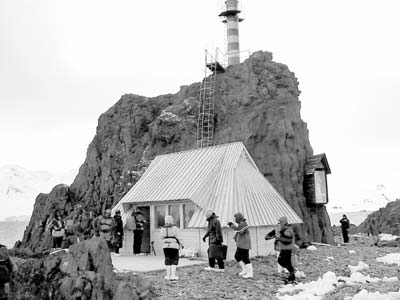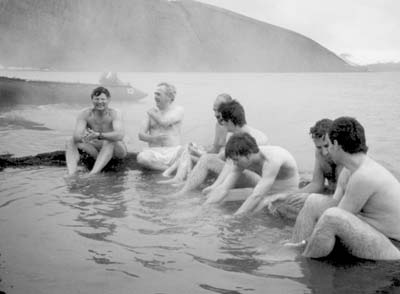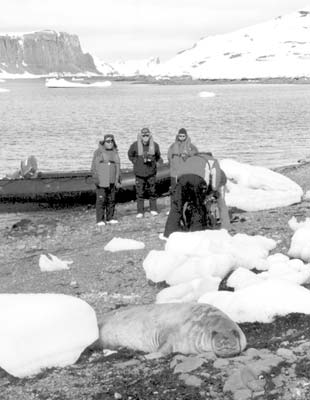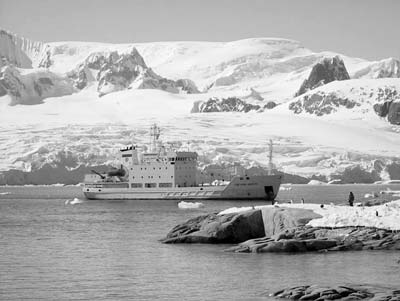Far Horizons
This item appears on page 104 of the April 2004 issue.
The first air cruise to Antarctica
It is commonly known and accepted in the realm of international tourism that in order to experience Antarctica one must first conquer the dreaded Drake Passage, perhaps the most consistently rough ocean crossing in the world. Little did I ever dream that I would have the opportunity to tame this monster crossing in painless fashion, by avoiding it altogether.
In early December of 2003 I was fortunate enough to be invited to participate in the first-ever “air cruise” to Antarctica. This tour, in which we flew to Antarctica to meet our waiting ship, was operated by a new Chilean-based tour operator, Antarctica XXI.
The adventure provided the opportunity to travel again with my good friend Scott Jones, who resides in Chile and who, through his contacts in the Chilean tourism industry, was responsible for my inclusion.
Specially adapted aircraft
Our air cruise itinerary was based on flying aboard a specially equipped, chartered, 46-seat Dash 7 aircraft from Punta Arenas, Chile, to the Teniente Marsh Airstrip at Eduardo Frei Station, a Chilean military air base outpost on King George Island in the South Shetlands region of Antarctica. We were jumping over the Drake in both directions.
The key components to realizing Antarctica XXI’s air cruise dream were the securing of a suitable charter aircraft and overcoming the formidable concerns of the Chilean military in order to receive permission to land at Eduardo Frei Station.
During our more than 3-hour flight over the Drake, my thoughts flip-flopped between an appreciation of our bird’s-eye viewing of the awesome white and blue wilderness below and myriad “What if?” thoughts that the contemplation of an unfolding adventure tends to evoke.
We were the guinea pigs and trial dogs in this grand experiment. In terms of tourism, I was overtly aware that we were breaking new ground in a manner that over time could potentially dramatically change the face of tourism in Antarctica.
Antarctica touchdown
Upon our landing at Frei Station, we donned heavy weather gear and traversed the air base on foot through snow for about a half mile before arriving at a point where we could transfer by Zodiac to our ship, the Russian-crewed Grigoriy Mikheev. Our 43-passenger group would fill the ship. At Frei I luckily was able to secure and mail postcards from the open-on-demand post office located next to a small souvenir shop.
The Frei base is a strategically important center of Antarctic operations. Its primary purpose is to assist the Chilean Antarctic Institute in their collection of meteorological data, which helps in the coordination of many varied scientific programs. Recently, the airstrip was modified and extended to accommodate larger and heavier aircraft.
Frei is the largest base on its side of Antarctica and has a year-round population. Also, basic hotel facilities were recently constructed which can accommodate up to 100 visitors, most of whom are connected with research projects going on in the region.
The base is close to the Russian Bellingshausen Research Station, built in 1968 for the purpose of conducting ongoing atmospheric and biological studies. Also close by are Uruguayan, Chinese and Korean stations that benefit from the cooperative sharing of the vital Frei base airstrip.
Cruise itinerary
Our cruise in Antarctica aboard the M/V Grigoriy Mikheev was a relatively standard 6-day/5-night itinerary. We were fortunate to enjoy good weather and calm cruising during almost the entire cruise, and we experienced no problems with our twice-daily (three on one day) shore excursions.
In all, we visited 13 sites, cruising approximately 1,367 kilometers. We were awed by the magical beauty of the icebergs at sea and the snow and ice fields on shore. Wildlife sightings included four varieties of penguin (gentoo, chinstrap, Adélie and macaroni), orca and minke whales, four types of seals, (Weddell, Southern elephant, crabeater and leopard) and a variety of seabirds.
Special experiences included languishing in the hot springs that bubble up from under the beach at Deception Bay. I and about 10 other souls of questionable intelligence accepted the challenge.
The trick was to diligently keep channeling the sand rim of our shovel-dug cutout to allow just enough icy seawater into our really hot, hot pool to keep the temperature just cool enough to be manageable. Most passengers were content to gawk and cackle in cowardly amazement at this brazen exhibition.
The Antarctica XXI alternative
The primary purpose of this article, however, is to enlighten readers regarding the new air cruise alternative for visiting Antarctica that our group of writers, tour operators, photographers, film makers and a small contingent of Spanish physicians experienced.
The air cruise option means being able to avoid the Drake Passage crossing, which can represent two to three days of potentially very rough and, to many, if not most, generally unpleasant sailing in each direction. This alternative reduces a typically 10- to 11-day cruise to six days.
An additional bonus of the air cruise itinerary is an increased opportunity to, in the same journey, visit additional destinations in proximity to the Punta Arenas, Patagonia, air cruise embarkation point or other places in Chile or Argentina.
The easiest southbound routing for most North Americans is via LanChile from the airline’s New York, Miami or Los Angeles gateways to Santiago, Chile, taking connecting flights to Punta Arenas without having to change air carriers.
Of course, this also provides the opportunity for breaking up the trip in Santiago to explore some of the central region of Chile or making easy flight connections to other regions of this diverse country.
Air cruise realities
Some may not prefer the new air cruise option because the program is reduced in time. The Drake crossing does allow more time for lectures and easing into and out of the Antarctica experience. The longer standard cruise itineraries likely will remain preferable to most travelers who are not motivated by the opportunity to save time or avoid the Drake Passage crossings. This is as it should be.
It is also important to understand that the Antarctica XXI air cruise program does require some flexibility of scheduling because flights into and out of Antarctica are very much weather related. There does exist the possibility of a weather-related delay, likely to be no more than a day in Punta Arenas on the outbound leg and at the Frei base station on the return.
In the case of weather-related delay on return, passengers may be required to accommodate at the Frei base hotel for a day or, in extreme cases, two days, at no additional cost, before flying back to Punta Arenas. After all, this is the wild Antarctic, and such unknown factors must be allowed for and be considered part of the adventure.
Antarctica XXI departures and contacts
Antarctica XXI is now scheduled to operate three air cruise programs in 2004, with departure dates of Nov. 30, Dec. 5 and Dec. 10 from Punta Arenas. Twin-cabin prices range from $5,900 to $7,900 and include the Antarctic flights.
For details of the air cruise program, contact Antarctica XXI (phone 56-61-228-783, fax 56-61-220-694, e-mail sales@antarcticaxxi.com or visit www.antarcticaxxi.com).
IAATO consciousness
On this journey it was my great pleasure to meet, travel and develop a friendship with Denise Landau, Executive Director of IAATO (International Association of Antarctica Tour Operators).
This all-important self-regulatory group is the entity that is recognized worldwide for advocating, promoting and practicing safe, environmentally responsible travel to Antarctica. IAATO faces an ongoing, often daunting management task that must balance scientific, political and tourism concerns of parties with widely varying needs, motives and agendas.
I urge all readers considering travel to Antarctica to visit the IAATO website, www.iaato.org. A strong case can indeed be made for traveling to Antarctica only with tour operators who are IAATO members.
Keck's Beyond the Garden Wall
❝To venture forth on soaring wings
Into the vastness of the great ice wilderness,
Beyond the reaches of the known,
An experience, one is prone to surmise,
Adventurous souls would ne’er be loath to covet.❞
— Randy reflecting on his mode of access to Antarctica





